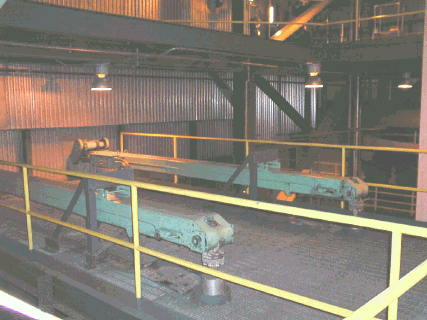 |
||||||||||||||||||||||||
|
Sootblower Valve
Application Discussion When firing fuels such as coal, oil, biomass or other waste products fouling of the boiler tubes becomes a concern. Deposits from the combustion process can collect on the heat exchanging tubes reducing thermal efficiency and can cause operational difficulties. In order to keep the unit operating, an online cleaning method must be used. This is usually accomplished by using what are called sootblowers. Sootblowers utilize flowing media such as water, air or steam to remove deposits from boiler tubes. There are several different types of sootblowers used. Wall blowers are used for furnace walls and have a very short lance with a nozzle at the tip. The lance rotates as it moves into the furnace and cleans the deposits from the wall in a circular pattern. Retractable sootblowers (Figure 1) are used in convection passes and high flue gas temperature zones. These operate the same as the wall blower, but the lance is inserted into the boiler to clean the internal tubes and can be partially or fully retractable. Partially retractable sootblowers are used where sootblower materials can withstand the flue gas temperature. These are commonly found in the back passes of the boiler, namely the primary superheater and economizer sections. Fully retractable types are used in high temperature areas where the sootblower can not withstand the temperature without the use of a cooling flow through the sootblower. These can be found in the secondary superheater and reheater tube banks.
Figure 1: Retractable Sootblower Arrangement Most sootblowing systems utilize either air or steam. Widespread use of water has been limited due to the possibility of thermal shock on the tube banks. Air or steam systems each have their own advantages, but one is not considered better than the other is. Air systems have much simpler piping arrangements. This is due to the elimination of condensate drain piping. The number of compressors, compressor capacity and the sootblower flow requirement, however, limits this system. Steam systems have an advantage in terms of expansion. The supply of steam (typically removed after the primary superheater) is virtually unlimited, but leads to additional maintenance concerns related to the numerous valves required. Also, as stated above, the steam systems require additional piping to address the possibility of condensate in the steam lines. As high pressure air or steam is required to remove the deposits from the boiler tubes, the control valve must be able to withstand high pressures. Steam systems present a greater challenge due to the combination of high pressure (2400 – 3600 psig) and temperature (650F – 950F). Because of the high inlet pressure, downstream pressure and pipe size, the valve must also withstand issues with noise and vibration. As the sootblowers operate intermittently, tight shutoff (Class V) is required for valve trim protection and when using steam, maintaining unit efficiency. Whether the blowing media is air or steam, Fisher recommends the use of what is called sootblower trim. This trim is designed to address the noise, vibration, shutoff and thermal cycling seen in this application. |
|
|||||||||||||||||||||||

